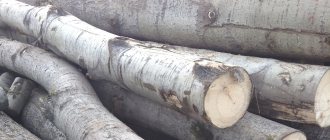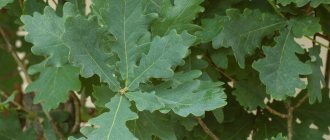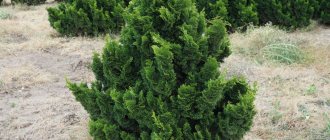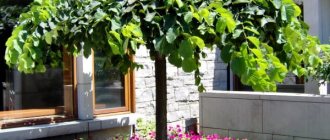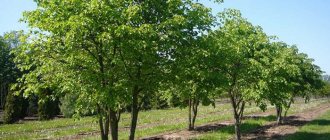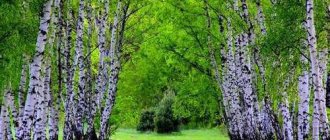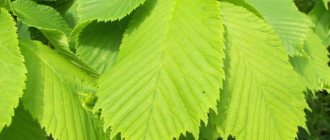Slender beauties of birch, which can be found not only in forests, but also in city parks, on the streets and in public gardens, were once animated by the ancient Slavs and Druids and were considered sacred. The Birch family includes 6 genera of trees, which are divided into 234 species.
The most beloved and revered tree among the peoples of different countries was the birch tree. They dedicated poems to her, made up legends about her, used her medicinal juices and brought gifts. All trees that are part of the Birch family (representatives are hornbeam, alder, hazel, birch and others) have healing properties that are still used in medicine today.
Birch family
Anyone who has ever been to a birch grove knows that the air there is unusually clean. This is due to the fact that the leaves of this tree emit phytoncides - special antibacterial substances that can purify polluted air. People of antiquity knew this feature, and modern city planners used it to clean city streets from exhaust gases. That is why the most common tree in any public park is from the birch family. It also includes: hornbeam, hazel, alder, hopshornbeam and ostriopsis.
The well-known white birch is divided into warty and Fastigiata. The Birch family belongs to deciduous trees, wind-pollinated and monoecious.
Side effects and contraindications
Birch bark should not be taken in the following cases:
- individual intolerance to the product;
- kidney problems;
- during pregnancy and lactation;
- during therapy with penicillin-based drugs;
- in combination with medications containing glucose;
- for dysentery and colitis.
When used correctly, birch bark does not cause adverse reactions. But if you use this product irrationally, some problems may arise. Therefore, it is always worth remembering that this remedy is auxiliary, and self-medication can cause negative consequences.
Birch warty
The silver birch (Betula verrucosa) grows in Europe, North America, Central Asia and North Africa. This tree reaches 30 m in height and can live up to 120 years or more. The bark of a young tree is brownish, but by the age of 8 it becomes white. It is for its color that it got its name. Translated from ancient Celtic, betu means “white,” which is why the dye in birch bark is called betulin.
The warty birch got its name due to the resinous glands located on its branches and looking like small warts. Leaves are what unites the Birch family. The general characteristic concerns, first of all, them. They are double-toothed, alternate, reaching a length of 4 to 7 cm, a width of 2 to 5 cm in most birch species. More often they are smooth or slightly covered with villi, but they are also found with “felt” pubescence.
The root system of the warty birch is powerful, but can be both superficial and deep. Prefers soil that is fertile, fertilized and rich in minerals. This tree blooms from April to May, the fruits (small nuts) ripen in August–September. Propagated by seeds.
Chemical composition of birch bark
Birch bark is heterogeneous. It consists of two clearly distinguishable layers: birch bark (white outer layer) and bast (inner layer). In medicine, birch bark is mainly used, which contains useful betulin. Bast contains much less substances important for the treatment of diseases.
The chemical composition of birch bark is very diverse:
- betulin, betulinic and betulonic acids;
- aldehydes;
- polysaccharides;
- tannins, resins;
- nicotinic and palmitic acids;
- wax;
- bioflavonoids;
- coumarin.
The use of birch bark in medicine is also due to the presence of many macro- and microelements useful for the human body, such as cobalt, calcium, vanadium, iron, strontium, selenium, boron, magnesium, barium and chromium.
Birch Fastigiata
This variety of warty birch differs from it in the structure of its crown. It is narrow and wedge-shaped, and the branches stretch upward, unlike its drooping “relative”. With a small height of only 10 m, Fastigiata (Birch family) has a very powerful root system and a wind-resistant trunk.
This tree grows very quickly - up to 40 cm per year, and its life expectancy rarely exceeds 100 years. The foliage is the same as that of warty birch, but lasts much longer, until late autumn. It blooms with small green, irregularly shaped flowers up to 1 cm long.
This tree tolerates both dry summers and cold winters equally well. Natural pests are chafer beetle, chimney beetle (beetle), Bucephalus corydalis, birch sapwood and nun moth.
Medicinal properties
With the help of birch bark you can cure:
- Gout.
- Lung diseases.
- Skin diseases and inflammations.
- Fungus on the skin.
- Dropsy.
- Malaria.
Also birch bark:
- normalizes the functioning of the gastrointestinal tract;
- speeds up metabolism;
- promotes rapid healing of wounds;
- strengthens the immune system;
- improves appetite.
Like birch bark, the work of the gastrointestinal tract is normalized by: bathwort, calendula, meadow sage (salvia), linden, chervil, Lyubka bifolia, watercress, yucca, dodder, viburnum buldenezh, goldenrod, onion, peanuts, oregano ( oregano) and kale.
Alder
Although alder is included in the Birch category, the family cannot boast of a more extraordinary tree than this. It is unique in everything:
- Firstly, it first blooms and then opens its leaves.
- Secondly, alder “opens” spring. Its flowering begins when there is still snow on the ground, and warmth is only anticipated in the air.
- Thirdly, its leaves do not turn yellow, but remain green in late autumn.
- Fourthly, alder foliage is so filled with nitrogen that it itself fertilizes the soil on which the tree grows.
- Fifthly, the unique property of its wood becoming harder under the influence of moisture makes it indispensable in the construction of wells and the manufacture of barrels.
Although there are up to 50 species of this tree, the two most common are black and gray alder. It got its name black (sticky is the second name) due to its trunk, which darkens as it matures. It is called sticky because of its leaves. Most often it grows alone or in a group of similar trees. Black alder begins to bloom in April, and the fruits fully ripen only after a year. Loves light and moisture.
Gray alder has not only a trunk of this color, but also leaves. It is unpretentious, frost-resistant and grows even on poor soil. Since gray alder tends to quickly grow into impenetrable thickets, it is most often planted to secure the banks and slopes of hollows and ravines.
Preparation of healing potions
And now we move on to the most important thing - the process of preparing medicinal drugs. The recipes are simple, and birch bark for cooking can be purchased at a pharmacy if you don’t have the time or opportunity to get it yourself.
Did you know? One of the types of birch - Schmidt birch - is also called iron birch, since the strength of its wood is equal to the strength of this metal, and the tree is also highly resistant to fire.
Decoction
For preparation you will need:
- 60 g birch bark;
- 1 liter of boiling water.
Dried birch bark must be crushed, placed in a saucepan and filled with boiling water. Then place the pan on the stove and bring the liquid to a boil. After it boils, turn down the heat and leave the broth to simmer on the stove for 40-50 minutes. During this time, about 0.4 liters of liquid should evaporate. Then the broth is filtered and taken 100 ml 3-5 times a day.
This decoction will help cope with cough and facilitate phlegm discharge. It should be taken until the condition improves. This decoction can also be used externally and cure foot fungus, skin diseases and scabies. To do this, you need to wipe the affected area with a cotton swab or soft cloth soaked in the medicine 2 times a day.
You can make tea from birch bark, which perfectly tones and is a general tonic. The raw materials must be poured with boiling water and allowed to brew for 7-10 minutes.
Tincture
Required ingredients:
- 200 g birch bark;
- 200 ml of alcohol or vodka.
The raw materials are crushed and filled with vodka or alcohol, and sent to infuse for 7-10 days in a dark, cool place. After the specified time, the liquid is filtered. The infusion is used externally in the treatment of skin diseases, including melanoma, and is also effective for radiculitis and joint pain.
In addition to birch bark, the following are also used in dermatology: medicinal comfrey (larkspur), horsetail (horsetail), aniseed lofanthus, asparagus, verbena officinalis, Echinops, parsnip, peony, melon, acacia honey and feijoa.
Hornbeam
The Birch family also includes hornbeam. China and Asia are considered its homeland. It thrives in both shade and sun, but prefers moist soil, so in dry summers it needs additional watering.
In terms of life expectancy, the hornbeam does not fit into the Birch family, the characteristics of which are generally the same, and the average reaches 100-120 years. The same tree easily lives up to 300 years, growing up to 30 m in height and up to 8 m in width.
The hornbeam blooms with small male and female inflorescences in the form of earrings, but begins to bear fruit only after 15-20 years. The wood of this tree is used to make furniture and kitchen utensils, but only after special treatment to prevent rotting, since it absorbs moisture and quickly deteriorates.
Hazel
The entire birch family, whose representatives bear fruit with nuts, cannot boast of fruits as tasty as those of hazel. Hazel, as it is popularly called, has a leaf shape reminiscent of bream, for which it was called hazel. They are dark green above and light green below.
Common hazel rarely grows above 7 m and has two types of flowers - male flowers in the form of earrings and female flowers resembling buds. The fruits of this tree are light brown in color, edible and have both excellent taste and benefits.
Sometimes common hazel is called hazelnut, but this is not entirely true. Hazelnut is its cultivated species, and its fruits are much larger and more nutritious.
In total, there are 20 types of hazel in nature, some of which are bushes, and others are tall trees, reaching 30 m in height, for example, like the bear nut, which grows up to 200 years. And variegated hazel - a shrub of the birch family - does not exceed 3 meters in height and produces the same tasty, but not as nutritious fruits as its ordinary variety.
For what diseases is birch used?
Birch buds and leaves are used as a diuretic and choleretic agent. Birch buds are recommended for bedsores, irritations and erosions of the skin, and externally for rheumatism, as a wound-healing agent, internally for colds, illnesses and stomach cramps, for tuberculosis, gastritis, acute and chronic eczema. Birch buds contain essential oils, saponin, glucose, resin, betulorethic acid, and leaves - anthocyanins, coumarins, flavanols, saponins, essential oil, resin, carotene, vitamin C.
Birch tar, which is obtained by distillation from birch bark, is used as a wound healing agent and for the treatment of skin diseases, burns, scabies, and lichens. Birch essential oil is also extracted from it, which is used as an anthelmintic. Activated carbon tablets are used for poisoning, bacterial toxicosis and flatulence.
Externally, birch leaves are used for baths for radiculitis, fresh leaves are applied to sore spots for rheumatism, infusion of buds or leaves is poured into wounds, for scurvy, gums are rubbed with buds, leaves are applied to tumors and injured areas; Infusion of the leaves is used to lubricate the affected areas for skin diseases, and to wash the hair in case of hair loss.
Birch bark is applied to boils. Birch bark (bark) is used to apply bandages for bone fractures.
Hmelegrab
This tree is poorly known in Europe, since its species grow in North America, Japan, Asia Minor and the Caucasus.
Hop hornbeam grows up to 25 m in height, has a tent-shaped crown, brown bark and finely toothed alternate leaves. In nature, there are only 4 types of these trees:
- Virginia hop hornbeam (American) is found on the streets and parks of Kyiv, Moscow and St. Petersburg, but is the least common of the birch family.
- The common hop hornbeam loves warmth, so it grows in the Caucasus, the Mediterranean and Asia Minor.
- Japanese - found only in China and Japan.
- Nolton's hop hornbeam grows only in North America and is not known at all in Europe.
Attempts to grow these tree species in areas with cold winters have not yet been successful.
Application in medicine
Birch bark is used in both folk and traditional medicine. It is included in many medicines and herbal preparations. This is due to the fact that she:
- helps with inflammatory processes;
- relieves high fever;
- stabilizes metabolism;
- promotes weight loss and weight gain;
- very quickly copes with wounds and purulent formations on the skin, helps in the treatment of melanoma (skin cancer).
In addition to birch bark, red root (forgotten kopeck), yarrow, lungwort, ginkgo biloba, Kalanchoe, calamus, shadberry, ivy, kirkazon (Aristolochia), meadow sage (Salvia), propolis and broccoli are also recommended for inflammatory processes.
Ostriopsis
This is a genus of flowering shrub plants native to China and Mongolia. They grow from 3 m to 5 m in height and are divided into 2 types:
- Ostriopsis David is a shrub 3 m in height with wide ovate leaves, pubescent shoots and staminate flowers in cylindrical earrings.
- Ostriopsis noble - has male and female flowers and fruits in the form of small nuts collected in fruit.
This plant is poorly known in Europe, so it can only be seen in its homeland.
